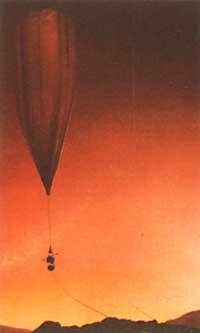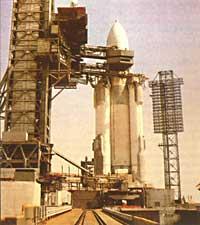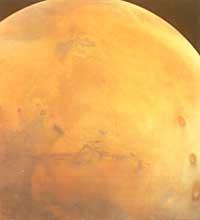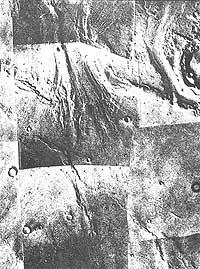Martitz Balloon
1990/10/01 Blamont, Jacques Iturria: Elhuyar aldizkaria

When my friend Eslaba Likin, from the SEBS Space Research Institute, informed me of the suggestion, I proposed that early in the morning (when the atmospheric gas inside the globe warms the suns) I could fly during the day and stay overnight somewhere. Initially the system needed two balloons. Since then, the study by the French space agency (CNES = Centre National d’Etudes Satiales) has shown that the same work can be done using a single balloon. That is the design to be used in the Franco-Soviet mission Martitz 94.
The French-Soviet working meeting held in September 1986 on the Black Sea coast reached consensus between the two sides and began to analyze how the Martian globe could be.
Very light and large balloon
It was not easy to decide how the globe could be, because God had not created Martitz's atmosphere for humans to fly there. The atmospheric density at ground level is equal to that existing at an altitude of 35 km in the Earth's atmosphere. Therefore, the balloon had to be very light and very large. Light weight meant having a very fine fabric, so the size of the balloon was very limited. Handi means that the total volume had to be several thousand cubic meters, which would allow it to stay without taking into account the payload. The load that can be carried until Tuesday is limited, so the maximum load that the balloon could carry was 20-25 kg.
The current design takes into account the 15 kg aerial gondola and the 13.5 kg guide rope hanging. At night, part of the latter is buried to the ground. The Soviets have made the balloon and gondola inflation system, and the French will make the balloon and guide rope.
From the beginning, what the balloon could do was very clear: collect the field data needed to design in the future vehicles and other useful that will be installed on the surface of Mars. At that time the USA and the Soviet Union were preparing special missions to Mars; missions that will bring soil samples to Earth on Mars. As a forerunner of these missions, the balloon can make a multitude of high-resolution images, measure the reflection of the stones and probe the ground up to a kilometer deep by electromagnetic waves. As you can travel thousands of kilometers along the mission, the globe can explode many places.
The limit of current plane missions is that the resources you can bring are limited to those who can leave the Earth. For example, the balloon would carry a limited amount of holding gas, so the balloon should be designed based on that specific and limited amount of gas.
One of the most limited and precious resources is energy. All the energy the globe needs is supplied by batteries. The mass limit prevents transporting more than 3 kg of batteries. This can reach a maximum of 1 kW/h during the mission. The expected duration is about ten days.

In the instrumentation of the globe, the greatest dissipating energy will be the radio station that transmits the data obtained by the globe. Since the energy required for the direct emission of data to Earth would be very large, the data will be sent to a satellite orbiting Martitz and then forwarded to Earth.
Data Drowning
In 1986 the balloons used by the Soviets on Venus transmitted data directly to Earth at a very low speed: 2,400 bits per hour. An image of 500 by 5,000 pixels contains approximately 2 million bits. The direct emission of such an image to Earth would require a continuous transmission of three days.
So from the beginning we planned that a Soviet satellite would receive data. The orbit of this satellite is eccentric (very elliptical) and the apogee, the furthest point, lies between 10,000 and 20,000 km from the surface of Martitz. This type of eccentric orbit is necessary to synchronize the satellite with the Earth's rotation. On the other hand, the satellite will receive the data for half an hour twice a day of the balloon.
Under these conditions, the power supply of the globe can ensure a transmission speed of 16 kilobit/s. This at best means 60 images a day.
Let's think that we want the camera to take 10 cm resolution photos to be able to choose the place where Martitz's future vehicle will stand. Every image (500 x 500 pixels) shows us the 50 x 50 m square of Martitz's surface. Under these conditions, one-day work will cover an area of 1,000 x 300 m.
If the objective of the balloon is to make many photos on Mars, something must be done to relieve the strangulation of the transmission.
Desire to walk

In late 1986, NASA organized a working group under the direction of Martitz expert Michael Kv of the US Geology Institute. The task force had an obligation to define the scientific objectives of a possible mission that included the parameters of sending the automatic vehicle to Mars/sample collection/sample input to Earth. I was part of that group and in late May 1987 we met at the Jet Propulsion Laboratory in Pasadena, California. The extrinsic objective of the group was to define as soon as possible what innovations could be introduced in the scientific load of the Mars Observer probe.
The work of the NASA Mars Observer consisted of studying the surface geology and climatology of the red planet. The mission had been delayed from 1990 to 1992 due to budget problems. However, in 1987 there was very little time and only small changes could be made.
On May 22, at a group meeting, my spirit of walking was out of class and I got an idea: Mars Observer will be placed in circular orbit and cross the equator of Martitz at 360 km altitude twice a day, at two in the morning and at noon. This means: Any station, located on the surface of Martitz, paralyzed or in slow motion (the globe), will “see” twice a day Mars Observer, at two noon and at dawn.
The minimum orbit distance between the Mars Observer and the ground station ranges from 360 to 900 km. Therefore, much closer than the Soviet satellite of the mission Martitz 94, which will be 10,000 km. The idea was based on: Use of Mars Observer to globotics for data collection and transmission, since using the same energy can transmit much more information.
I immediately explained the idea to several friends of the group and everyone told me to go deeper. With a little time working at home, I realized: That the installation of a small antenna in the Mars Observer allowed data to be received at 160 kilobit/s. Compare to the 16 kilobit/s speed of the Soviet probe! The team director was fascized: The energy supply of the globe's mission is limited, but the first calculations indicate that the presence of a receiver in the Mars Observer may be very convenient for the balloon mission. At the same time, it is very suitable for the small sustainable station that we want to propose to the Soviets.

At the next working group meeting (29 June in Houston, Texas), I presented the idea and suggested that it could be presented at the EBB/SESB Cooperation Group meeting that was about to take place.
So I knew the entire Mars Observer data system was already “reserved.” To address this issue, I proposed to send data through the Mars Observer (MOC) camera and save data to MOC memory. The MOC data system, duly formatted with the globe data, will not differentiate your data from those sent by the globe, so no additional hardware will be loaded into the probe. Without that trick, the proposal would have been suspended.
More meetings
My idea was enthusiastically taken and was the first on the proposed change list for the Mars Observer mission. NASA immediately commissioned a pre-study. The idea managed to pass the exam and seemed increasingly healthy from a technical point of view.
At that time he had to climb a great mountain. He had to sell a curious idea to the American, Soviet and French space agency; to use as the main subsystem an American tool in a Soviet mission. Perestroika was not yet fully accepted.
Slavic Linkin, a Soviet of the Cooperation Group, agreed to present my proposal as a Soviet proposal: The Martitz 94 project broadcasts an antenna to be part of the Mars Observer mission. The American satellite will arrive on Mars in 1993, carrying out its work and acting as a data transmitter of the globe that a Soviet mission will release on the surface of Mars.
The proposal advanced and I read in Aviation Week magazine on December 21, 1987 the following motto: Soviets Propose Realy Role for Mars Observer Mission . The article read: The administration and NASA were seriously and in depth studying the Soviet proposal. Then the secret covered him.

During the worst and dark paths of the bureaucracy it took a year to make the decision: The French space agency CNES, subcontracted Soviet, would supply a receiver to JPL (Jet Propulsiopn Laboratory). The agreement between both parties remains unsigned, despite the fact that the company Alcatel-Espace in Toulouse (France) is currently carrying out equipment.
1000 images per day
The Martitz balloon transmission system is experienced and I proposed to the CNES to use it in the EOLE project in 1963. According to this proposal, in 1971 the CNES released 500 balloons in the atmosphere at an altitude of about 20 km and collected atmospheric data. Subsequently, a French space put in the air by American launchers collected weather data obtained by balloons.
It will work similarly to Martitz: The French equipment installed in the Mars Observer will launch the electronic equipment of the globe, which will respond to the satellite at a speed of 128 kilobit/s. The duration of the transmission (300-1000 s) depends on the relative positions of the balloon and the satellite.
The balloon gondola will transmit the data stored in its memory of 32 megabites in previous hours and, once it is finished, proceed to what is being seen at the time, as long as the transmission is carried out in hours of light. No real time transmissions will take place during the night.
Thus and through a technique of image compression, we hope to get 1000 images daily.

Gai honi buruzko eduki gehiago
Elhuyarrek garatutako teknologia





